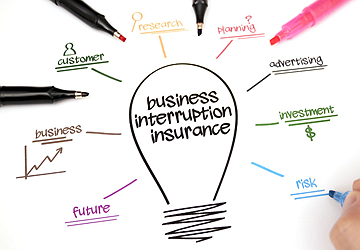Business interruption insurance can be a lifesaver when unexpected events disrupt your operations. Whether it's a natural disaster, supply chain disruption, or a global pandemic, having the right coverage can mean the difference between swift recovery and financial downfall.
In this article, we'll guide you through the process of evaluating and optimizing your business interruption insurance, ensuring you're well-prepared for any curveballs that come your way.

Understanding Business Interruption Insurance:
Business interruption insurance, also known as business income insurance, is designed to compensate you for income lost during periods of forced closure or reduced operations due to covered events. It covers expenses like fixed costs, temporary relocation, and profits that would have been earned had the disruption not occurred. To effectively evaluate your policy, start by thoroughly understanding the coverage it offers and the specific events that trigger it.
Understanding your policy's terminology and definitions is crucial. For example, make sure you grasp the distinction between "actual loss sustained" and "gross earnings," as they can significantly impact the compensation you receive. By delving into these intricacies, you'll be better equipped to interpret your policy's terms and conditions accurately.
Assessing Your Risk Profile:
Each business has a unique risk profile influenced by location, industry, and supply chain dependencies. Evaluating your risk profile helps you determine the appropriate coverage limits. Consider potential threats that could halt your operations and estimate the time it might take to resume normal activities. This assessment will guide you in selecting a policy that aligns with your risk tolerance and financial capabilities.
Moreover, consult with industry peers or risk management professionals to gain insights into the risks they've encountered. Their experiences can shed light on potential blind spots you might have missed during your risk assessment, helping you fine-tune your insurance strategy further.
Coverage Adequacy:
Once you've assessed your risk profile, scrutinize your policy's coverage limits. Is the coverage amount sufficient to cover lost income, ongoing expenses, and any additional costs that may arise during a disruption? Pay attention to sub-limits, deductibles, and waiting periods. Keep in mind that skimping on coverage to save on premiums could leave you underinsured when you need it most.
Remember that underinsurance can lead to financial strain in the aftermath of a crisis. Take a strategic approach by calculating the worst-case scenario and ensuring your coverage adequately cushions your business during tumultuous times.

Reviewing Exclusions and Inclusions:
Thoroughly examine the list of covered events and exclusions in your policy. Certain events like earthquakes, floods, or pandemics might require separate endorsements. Conversely, exclusions could leave you vulnerable to risks you thought were covered. Request clarifications from your insurance provider to ensure you have a clear understanding of what your policy encompasses.
Beyond the policy's printed exclusions, discuss hypothetical scenarios with your insurer. These discussions can help you understand the extent of coverage for specific scenarios and potentially negotiate better terms. By leaving no stones unturned, you can avoid unwelcome surprises when making a claim.
Calculating Business Income:
Determining your business income accurately is crucial for assessing your insurance needs. Calculate your potential earnings based on historical financial data, considering factors that might influence revenue fluctuations. Projection tools can help estimate income during different recovery phases, giving you a more realistic picture of the financial impact of a disruption.
While estimating income, account for changes in customer behavior during a crisis. For instance, if your business relies heavily on foot traffic, anticipate a temporary decrease in sales and adjust your income projections accordingly. This nuanced approach to calculations ensures you're adequately protected against revenue shortfalls.
Reviewing Extra Expense Coverage:
In addition to covering income loss, business interruption insurance can include extra expense coverage. This helps reimburse you for additional costs incurred to resume operations more quickly. Evaluate whether your policy adequately addresses expenses like temporary relocation, equipment rentals, or outsourcing, ensuring that you can recover swiftly without straining your finances.
When considering extra expenses, explore ways to minimize them in the event of a disruption. Implementing contingency plans and establishing backup suppliers can help reduce the financial burden, making your insurance coverage even more effective in supporting your recovery efforts.
Period of Restoration:
The "period of restoration" is when it takes to fully recover and resume normal business operations following a disruption. It's crucial to estimate this timeframe when selecting coverage accurately. Consider factors like repair and rebuilding time, supply chain recovery, and regulatory approvals. Opt for a coverage period that aligns with your industry's typical recovery timeline.
To determine an appropriate restoration period, consult with experts in your industry who have faced similar disruptions. Their insights can provide valuable benchmarks for recovery times, enabling you to make a more informed decision about coverage duration.
Documentation and Record-Keeping:
In the event of a claim, comprehensive documentation is your best ally. Maintain records of financial statements, expense receipts, and any communication with insurance representatives. This documentation speeds up the claims process and substantiates your losses, ensuring you receive the compensation you deserve.
Create a streamlined system for record-keeping that's easily accessible to relevant team members. This collaborative approach ensures that critical information is available to expedite the claims process, even if key personnel are unavailable due to the disruption.
Regular Policy Reviews:
Your business is dynamic, and so are its risks. Schedule regular policy reviews, especially when your business undergoes changes such as expansion, new partnerships, or alterations to your supply chain. Keeping your insurance coverage up-to-date guarantees that it remains aligned with your evolving risk landscape.
Additionally, involve your legal and financial advisors in the policy review process. Their perspectives can provide valuable insights into potential disruptions' legal and financial implications, helping you make well-informed decisions about coverage adjustments.
Conclusion:
Evaluating and optimizing your business interruption insurance is a proactive step towards safeguarding your business's financial stability. By understanding your policy's coverage, assessing your risk profile, and calculating potential losses accurately, you'll be better equipped to navigate disruptions and ensure a smoother recovery process. Regular reviews and clear documentation serve as your safety net, providing peace of mind that you're prepared for challenges. Remember, making informed insurance decisions today can make all the difference in securing your business's tomorrow.


